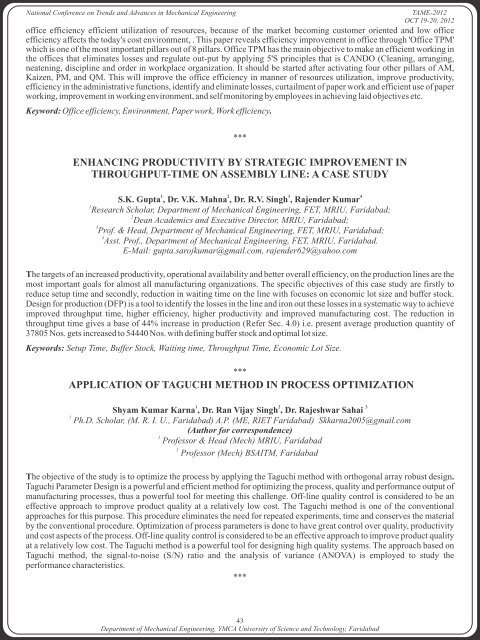Souvenir Containing Abstracts - YMCA University of Science ...
Souvenir Containing Abstracts - YMCA University of Science ...
Souvenir Containing Abstracts - YMCA University of Science ...
You also want an ePaper? Increase the reach of your titles
YUMPU automatically turns print PDFs into web optimized ePapers that Google loves.
National Conference on Trends and Advances in Mechanical Engineering<br />
TAME-2012<br />
OCT 19-20, 2012<br />
<strong>of</strong>fice efficiency efficient utilization <strong>of</strong> resources, because <strong>of</strong> the market becoming customer oriented and low <strong>of</strong>fice<br />
efficiency affects the today's cost environment, . This paper reveals efficiency improvement in <strong>of</strong>fice through 'Office TPM'<br />
which is one <strong>of</strong> the most important pillars out <strong>of</strong> 8 pillars. Office TPM has the main objective to make an efficient working in<br />
the <strong>of</strong>fices that eliminates losses and regulate out-put by applying 5'S principles that is CANDO (Cleaning, arranging,<br />
neatening, discipline and order in workplace organization. It should be started after activating four other pillars <strong>of</strong> AM,<br />
Kaizen, PM, and QM. This will improve the <strong>of</strong>fice efficiency in manner <strong>of</strong> resources utilization, improve productivity,<br />
efficiency in the administrative functions, identify and eliminate losses, curtailment <strong>of</strong> paper work and efficient use <strong>of</strong> paper<br />
working, improvement in working environment, and self monitoring by employees in achieving laid objectives etc.<br />
Keyword: Office efficiency, Environment, Paper work, Work efficiency.<br />
***<br />
ENHANCING PRODUCTIVITY BY STRATEGIC IMPROVEMENT IN<br />
THROUGHPUT-TIME ON ASSEMBLY LINE: A CASE STUDY<br />
1 2 3 4<br />
S.K. Gupta , Dr. V.K. Mahna , Dr. R.V. Singh , Rajender Kumar<br />
1<br />
Research Scholar, Department <strong>of</strong> Mechanical Engineering, FET, MRIU, Faridabad;<br />
2<br />
Dean Academics and Executive Director, MRIU, Faridabad;<br />
3<br />
Pr<strong>of</strong>. & Head, Department <strong>of</strong> Mechanical Engineering, FET, MRIU, Faridabad;<br />
4<br />
Asst. Pr<strong>of</strong>., Department <strong>of</strong> Mechanical Engineering, FET, MRIU, Faridabad.<br />
E-Mail: gupta.sarojkumar@gmail.com, rajender629@yahoo.com<br />
The targets <strong>of</strong> an increased productivity, operational availability and better overall efficiency, on the production lines are the<br />
most important goals for almost all manufacturing organizations. The specific objectives <strong>of</strong> this case study are firstly to<br />
reduce setup time and secondly, reduction in waiting time on the line with focuses on economic lot size and buffer stock.<br />
Design for production (DFP) is a tool to identify the losses in the line and iron out these losses in a systematic way to achieve<br />
improved throughput time, higher efficiency, higher productivity and improved manufacturing cost. The reduction in<br />
throughput time gives a base <strong>of</strong> 44% increase in production (Refer Sec. 4.0) i.e. present average production quantity <strong>of</strong><br />
37805 Nos. gets increased to 54440 Nos. with defining buffer stock and optimal lot size.<br />
Keywords: Setup Time, Buffer Stock, Waiting time, Throughput Time, Economic Lot Size.<br />
***<br />
APPLICATION OF TAGUCHI METHOD IN PROCESS OPTIMIZATION<br />
1 2 3<br />
Shyam Kumar Karna , Dr. Ran Vijay Singh , Dr. Rajeshwar Sahai<br />
1<br />
Ph.D. Scholar, (M. R. I. U., Faridabad) A.P. (ME, RIET Faridabad) Skkarna2005@gmail.com<br />
(Author for correspondence)<br />
2<br />
Pr<strong>of</strong>essor & Head (Mech) MRIU, Faridabad<br />
3<br />
Pr<strong>of</strong>essor (Mech) BSAITM, Faridabad<br />
The objective <strong>of</strong> the study is to optimize the process by applying the Taguchi method with orthogonal array robust design.<br />
Taguchi Parameter Design is a powerful and efficient method for optimizing the process, quality and performance output <strong>of</strong><br />
manufacturing processes, thus a powerful tool for meeting this challenge. Off-line quality control is considered to be an<br />
effective approach to improve product quality at a relatively low cost. The Taguchi method is one <strong>of</strong> the conventional<br />
approaches for this purpose. This procedure eliminates the need for repeated experiments, time and conserves the material<br />
by the conventional procedure. Optimization <strong>of</strong> process parameters is done to have great control over quality, productivity<br />
and cost aspects <strong>of</strong> the process. Off-line quality control is considered to be an effective approach to improve product quality<br />
at a relatively low cost. The Taguchi method is a powerful tool for designing high quality systems. The approach based on<br />
Taguchi method, the signal-to-noise (S/N) ratio and the analysis <strong>of</strong> variance (ANOVA) is employed to study the<br />
performance characteristics.<br />
***<br />
43<br />
Department <strong>of</strong> Mechanical Engineering, <strong>YMCA</strong> <strong>University</strong> <strong>of</strong> <strong>Science</strong> and Technology, Faridabad













